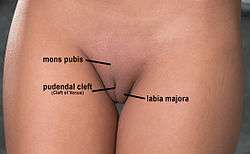Pudendal cleft
| Pudendal cleft | |
|---|---|
 Anterior view of human female pelvis, pubic hair removed, revealing the cleft of Venus | |
| Details | |
| Identifiers | |
| Latin | rima pudendi |
| TA | A09.2.01.006 |
| FMA | 19995 |
The pudendal cleft (also called the cleft of Venus, pudendal fissure, pudendal cleavage, pudendal slit, urogenital cleft, vulvar slit, rima vulvae, or rima pudendi[1]) is a part of the vulva, the furrow at the base of the mons pubis where it divides to form the labia majora. The name cleft of Venus is a reference to the Roman goddess of love, Venus.
In human females, the clitoral hood and labia minora protrude into the pudendal cleft to a greater or lesser extent. Given this diversity and the frequent portrayal of the pudendal cleft without protrusion in art and pornography, there has been a rise in the popularity of labiaplasty, surgery to alter the labia.[2]
See also
References
- ↑ Gould, George M. (1936). Brownslow, C. V, ed. Gould's Pocket Pronouncing Medical Dictionary (10th ed.). P. Blakinston's Son & C., Inc.
- ↑ Rowenna Davis (27 February 2011). "Labiaplasty surgery increase blamed on pornography". Life and style. Archived from the original on 2014-12-07. Retrieved 2015-04-03.
This article is issued from Wikipedia - version of the 9/7/2016. The text is available under the Creative Commons Attribution/Share Alike but additional terms may apply for the media files.